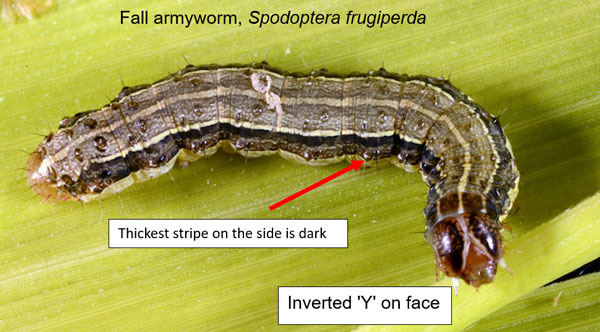Getting Ahead of Fall Armyworms
go.ncsu.edu/readext?1074927
en Español / em Português
El inglés es el idioma de control de esta página. En la medida en que haya algún conflicto entre la traducción al inglés y la traducción, el inglés prevalece.
Al hacer clic en el enlace de traducción se activa un servicio de traducción gratuito para convertir la página al español. Al igual que con cualquier traducción por Internet, la conversión no es sensible al contexto y puede que no traduzca el texto en su significado original. NC State Extension no garantiza la exactitud del texto traducido. Por favor, tenga en cuenta que algunas aplicaciones y/o servicios pueden no funcionar como se espera cuando se traducen.
Português
Inglês é o idioma de controle desta página. Na medida que haja algum conflito entre o texto original em Inglês e a tradução, o Inglês prevalece.
Ao clicar no link de tradução, um serviço gratuito de tradução será ativado para converter a página para o Português. Como em qualquer tradução pela internet, a conversão não é sensivel ao contexto e pode não ocorrer a tradução para o significado orginal. O serviço de Extensão da Carolina do Norte (NC State Extension) não garante a exatidão do texto traduzido. Por favor, observe que algumas funções ou serviços podem não funcionar como esperado após a tradução.
English
English is the controlling language of this page. To the extent there is any conflict between the English text and the translation, English controls.
Clicking on the translation link activates a free translation service to convert the page to Spanish. As with any Internet translation, the conversion is not context-sensitive and may not translate the text to its original meaning. NC State Extension does not guarantee the accuracy of the translated text. Please note that some applications and/or services may not function as expected when translated.
Collapse ▲Last fall, some Orange County producers experienced damage from fall armyworms. This small pest can cause substantial damage to pasture, hay fields, and lawns. Most people notice armyworms after the damage has been done and after pesticides are no longer effective. Although they are active in the fall, understanding when and what to look for can help minimize the damage caused.
The fall armyworms that we are familiar with are the larval stage of the armyworm moth. Storms and weather fronts distribute these moths from southern states to places like North Carolina. Adult moths lay their eggs in July on the underside of leaves in large masses of up to a couple of hundred eggs. Eggs will hatch within a couple of days to about ten days after being laid. Once the larva hatches, they begin feeding on vegetation for 2-3 weeks before burrowing into the ground. They are most active during the early morning and late afternoon hours, which is the best time to scout for them. Armyworm larva can be distinguished by the white “Y” on their head.
Armyworms are going to do the majority of their damage in the last 4 to 7 days of the larval stage of their life cycle. During the first week or so that they feed on vegetation, their intake is somewhat minimal and then their consumption skyrockets. At that point, pesticide treatment is not an effective option, especially when worms are over an inch long. If they are found in a hayfield, mowing quickly is recommended to reduce the amount of lost forage. If armyworms are observed at 3 caterpillars (between ¼ and ¾ of an inch) per square foot, pesticides can be an effective tool. The following link has a list of approved pesticides for use in pastures and hay fields: go.ncsu.edu/readext?618516. Do not use products on your pastures and hay fields that are not labeled for that application. There are products designed for lawns, so make sure to read the label before purchasing.
Stands that are heavily damaged may need renovation including seeding and fertilizing. In a cool season field, fertilizing soon after the damage is observed can help the forages get a boost before the fall growth curve. Overseeding can also be done the following spring if the desired regrowth is not met.





